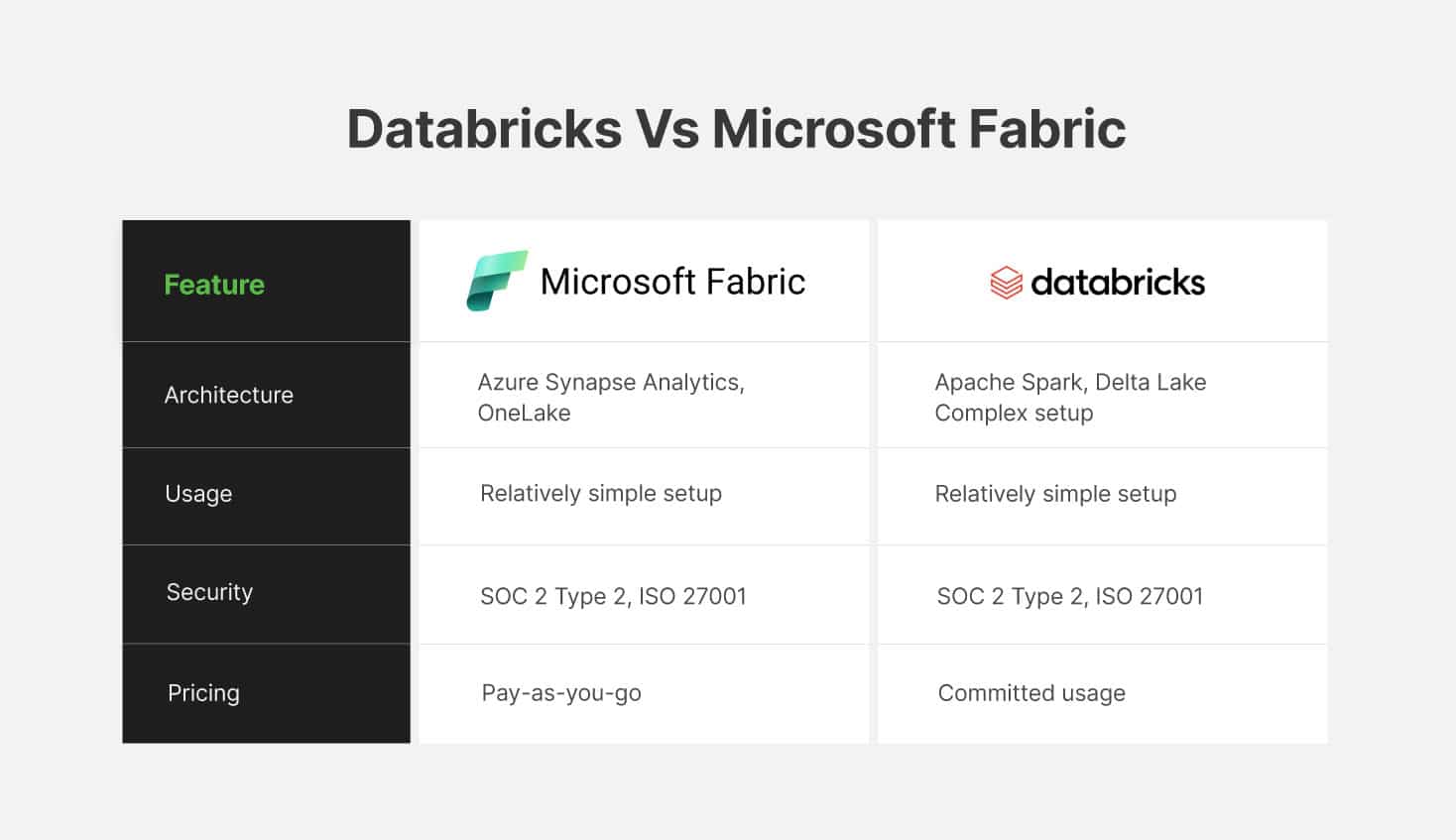
Data & AI Evangelist

Principal Data Architect
Subscribe to the newsletter
For years, Databricks has enabled organizations to work with all types of data, structure and unstructured, within a unified, user-friendly environment. Databricks has empowered enterprises to streamline their data workflows, accelerate insights generation, and drive innovation. In fact, over 7,000 organizations, regardless of their sizes, have been using Databricks for data engineering, advanced analytics, and data science.
However, in this evolving landscape of AI and data analytics platform services, Microsoft Fabric has emerged as a significant development, offering enterprises another all-in-one platform for their data analytics needs. Fabric provides a similar, unified solution that brings together experiences including Data warehouse, Data Science, Data Factory, Data Engineering, Real-time Analytics and Power BI into a shared SaaS foundation.
With Microsoft announcing Fabric as a robust data management and analytics solution, the question that has made everyone curious is whether they need to switch to Fabric or rely on Databricks if both serve the same purpose.
This blog will address these concerns and demonstrate how these technologies can optimize your organization’s data analytics needs.
What is Databricks?
Databricks is an open and unified analytics platform for Big Data processing, engineering, data science, and Machine Learning. It offers a robust and scalable environment built on top of Apache Spark, a powerful open-source engine for large-scale data processing. This analytics platform also provides unified data governance, security, and data sharing capabilities.
Databricks offers a cloud-agnostic approach and provides a powerful and faster environment for processing large volumes of data, running machine learning algorithms, and generating real-time insights. Databricks is supported on all three leading cloud providers, AWS, Azure, and GCP.
The Databricks workspace provides a unified experience for various data solutions, such as:
- Data processing scheduling and management, in particular ETL, and ELT
- Data discovery, annotation, and exploration
- Managing security, governance, high availability, and disaster recovery
- Generating dashboards and visualizations
- Machine learning (ML) modeling, tracking, and model serving
- Generative AI solutions
What is Microsoft Fabric?
Fabric, released by Microsoft in May 2023, is an advanced all-in-one analytics platform that brings together data, analytics, ML, and AI tools into a unified SaaS offering. This platform offers different user persona experiences, such as Data Engineering, Data Factory, Data Science, Data Warehouse, Real-Time Analytics, and Power BI, that eliminate the hassle of managing different tools and platforms.
Microsoft Fabric is a suite of highly integrated analytic tools and services designed to foster collaboration, and help organizations manage their data and AI journey from start to end.
Discover the real-time analytics capabilities of Synapse within the Microsoft Fabric ecosystem here.
Will Microsoft Fabric bring an end to Databricks?
Since both Databricks and Microsoft Fabric are advertised as unified data analytics platforms, businesses are in the state of questioning whether they should opt for Databricks or the new Microsoft Fabric platform.
It is highly unlikely that Fabric will fully replace Databricks as they both serve similar purposes within the analytics landscape. Databricks is a very mature, widely adopted platform in use by over 7,000 customers.
Microsoft Fabric is a solid choice for organizations needing a unified environment for data engineering, Machine Learning, and BI. Fabric operates and is supported in Microsoft Azure. Fabric also supports the use of storage and data across all three major cloud providers (AWS, Azure, and GCP).
If your focus revolves around an open platform that excels in providing Spark notebooks, Big Data processing and machine learning with optimized Apache Spark performance, Databricks is a great platform. Databricks is supported in all three major cloud platforms (AWS, Azure, and GCP). If your organization has adopted Databricks, then a full migration is not an attractive business case.
Microsoft Fabric comes with OneLake, an open and unified SaaS data lake for centralized organizational storage. OneLake offers a unified location to store all organizational data. Businesses looking to acquire the capabilities of Fabric and Databricks can simply leverage Fabric OneLake shortcut, allowing data usage where it resides without the need to copy or move it. Databricks offer similar functionality allowing organizations to connect data and storage across cloud providers like Azure and OneLake.
Businesses can create shortcuts for data within OneLake or external lakes like Azure Data Lake Storage Gen2 or Amazon S3. So essentially, businesses can access OneLake data in either of two ways:
- Use OneLake with existing Data Lakes
- Use data landed in OneLake directly
Databricks and Fabric complement each other, offering a full range of advanced analytics and AI solutions when used in conjunction. If your organization is just beginning to adopt analytics tools, you should evaluate Fabric and Databricks equally.
Databricks and Microsoft Fabric: The key differences
While both Databricks and Microsoft Fabric are powerful data analytics platforms, their approach and functionalities differ significantly. Let’s discuss the differences based on four major aspects.
- Architecture
- Usage
- Security
- Pricing

Difference #1: Architecture
Microsoft Fabric: Fabric is built on top of Microsoft platforms and services such as Azure Synapse Analytics and Azure Data Factory. Fabric provides analytics services for performing data, engineering, integration, analysis, including data visualization tools like Power BI, real-time analytics capabilities and data science tools.
Fabric’s architecture is scalable and flexible, enabling organizations to handle large volumes of data efficiently. Moreover, Fabric’s OneLake, a single and unified data lake, provides a single repository for storing large volumes of organizational data.
Databricks: The platform is designed and implemented following the open source, Delta framework. It is built using Apache Spark architecture and is optimized for performance across all volumes of data and ML processing. The foundation of Databricks is its Delta Lake capabilities, which are based on an open-source storage layer that brings transactional support, governance, and reliability to data lakes.
Difference #2: Usage
Microsoft Fabric: Fabric provides focused, user-based personas in the form of user interfaces that include data engineering, data factory, data science, data warehousing, real-time analytics, and Power BI.
Databricks: Databricks organizes its user interface around functions performed using the platform, including managing linked services, developing notebooks, governance, data warehouse and SQL access, and data visualization.
Difference #3: Security
Microsoft Fabric: Microsoft Fabric provides a complete security package with built-in features that secure data at rest and transit. Also, it ensures the recovery of your data in case of any infrastructure failure. Therefore, it is important to note that Fabric provides automated and configurable security. Fabric offers various security features like role-based access control (RBAC), data encryption (at rest and in transit), and integration with Azure Active Directory for centralized identity management.
Databricks: Databricks provides a complete package of security features, such as encryption, network control, data governance, auditing, protecting your data and workloads. Databricks offers various security features like role-based access control (RBAC), data encryption (at rest and in transit), and integration with Azure Active Directory for centralized identity management.
Furthermore, both Microsoft Fabric and Databricks use SOC 2 Type 2, ISO 27001, and HIPAA certification for data security.
Difference #4: Pricing
Microsoft Fabric: Microsoft Fabric pricing model is based on pay-as-you-go or reservation capacity. Microsoft Fabric capacity provides a shared pool of compute, network, and storage capacity. This powers all capabilities in Microsoft Fabric, from data modeling and data warehousing to BI and AI experiences (one-minute minimum). The platform offers a free trial for 60 days.
Databricks: Databricks cost plan is based on the pay-as-you-go or reserved pricing model with no up-front cost. Reserved pricing lowers the cost of use by committing to a minimum usage level. Databricks offers a free trial for 14 days on any of the three main cloud providers (AWS, Azure, and GCP).
Which platform is ideal for next-gen data solutions?
While both Microsoft Fabric and Databricks are reliable data analytics platforms, the right choice depends on your business’s objectives. However, if you have a Databricks setup and are considering Microsoft Fabric, both platforms can coexist and complement each other. The choice depends on your organization’s data and analytics strategy, and culture.
Still not sure about making the right decision? Look no further than Confiz. Our team provides valuable support to help you make the right decision for your organization’s data analytics journey. Contact us at marketing@confiz.com to transform your analytics game.



